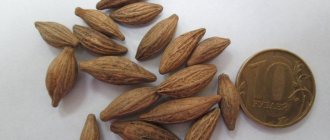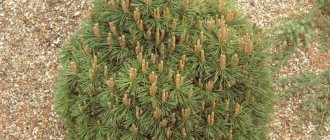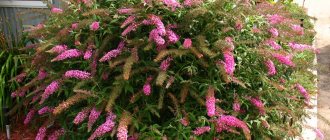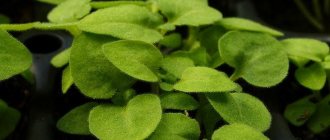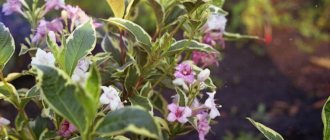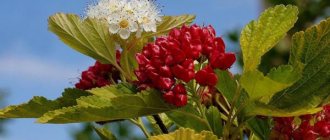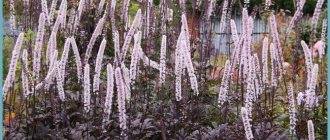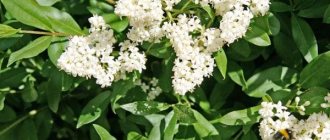15581
Mock orange is a deciduous shrub of the Hydrangeaceae family. It got its name back in the 17th century, when folk craftsmen learned to cut smoking utensils - chibuki - from the stems of this plant. The shrub is often confused with jasmine and is mistakenly considered a garden variety. The only similarity they have is their delicate floral aroma.
Extraordinarily beautiful flowering
A distinctive feature of mock orange is the white color of the inflorescences. Only some varieties have pinkish and carmine inclusions at the base of the buds. In this regard, it is difficult for a novice gardener to recognize one or another variety. It is best to choose a shrub in a nursery or in a specialized store, where the varieties of mock orange have a photo and description. Knowing about the species differences between these plants, it will be much easier for the gardener to choose both a care schedule and feeding options for the plant.
What is mock orange and how does it grow?
The Latin name of the mock orange, Philadelphus, comes from the Greek words “love” and “brother”, because the shoots of the bush are located opposite and close to each other. According to another version, the name of the deciduous shrub was given in honor of one of the kings of Ancient Egypt, Ptolemy Philadelphus.
Mock orange belongs to the Hydrangeaceae family. Botanists know more than 60 species of this plant growing in the wild. No more than half of all varieties of garden jasmine are cultivated.
What does mock orange look like?
All types of mock orange are similar in basic parameters. These are shrubs ranging in height from one to three meters with closely spaced opposite shoots. Its leaves are roundly elongated, sometimes pointed, small (5 - 7 cm), more often smooth, but also have jagged edges.
The bark of the plant is predominantly gray. In some types of jasmine it is brownish. In most varieties, the bark darkens on the shoots of the second year of life. For some completely, for others only at the base. The bark peels off on mature shoots.
Flowering of garden jasmine begins in late spring and lasts from a month to two. Its flowers are simple, white, from two cm in diameter, collected in inflorescences from 3 to 9 pieces, bloom on short side branches of the shoot. Most types of mock orange, or garden jasmine, as it is often called, have a delicate aroma. But there are also species without odor. In varietal hybrid varieties, the inflorescences can consist of double flowers and reach a size of more than 10 cm.
Blooming mock orange (jasmine) photo:
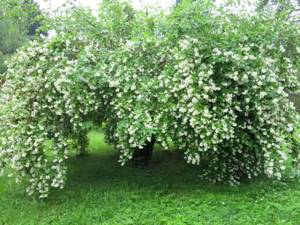
The mock orange fruit is not large. The capsules, consisting of several chambers, are filled with small achenes.
In nature, mock orange grows in regions with warm and temperate climates (north of the American continent, East Asia, Europe). The culture prefers the edges of deciduous or mixed forests. It is often found on rock slides and cliffs. Bushes grow one by one or in groups.
How fast does mock orange grow?
Gardeners classify garden jasmine as a fast-growing shrub. It only takes 2 - 3 years from the moment of planting for the height and size of the mock orange crown to reach the maximum for its variety.
Application of mock orange
Jasmine is universal in landscape design. Single bushes perfectly decorate garden gazebos and look original against the background of brick and stone walls of a house and other buildings. Due to the rapid growth of shoots, mock orange is suitable for creating hedges of various heights.
Photo of a single planting of a mock orange bush:
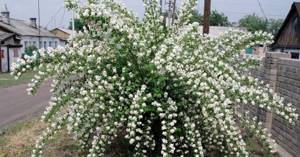
Planting and proper care
Despite the general undemandingness and ease of care of this species, in order for the plant to become a real decoration of your garden, it is recommended to create the most favorable conditions for its growth and development. The developed basic recommendations will provide practical assistance in organizing proper care for the crowned mock orange:
- choice of location
Considering the durability and size of an adult shrub, the choice of planting site must be approached in advance and carefully. Mock orange grows equally effectively both in open space and in partial shade, but the quality and duration of the flowering period directly depend on the lighting - in sunny areas the bush blooms longer and the inflorescences are larger;
- soil composition
In general, the plant is not picky about soil; the only limitation is that it does not tolerate soil salinity and wetlands. In heavy clay areas, it is advisable to arrange drainage. It is capable of fully demonstrating all its decorative qualities on almost any cultivated soil, so before planting it is recommended to improve the soil with organic matter or compost.
- landing
It takes root equally effectively both during spring and autumn planting. The roots of the seedling are placed in a small hole (depth and diameter up to 50 cm) up to the root collar and covered with fertilized soil. The soil around the planted shrub is compacted and then watered abundantly;
- pruning
After planting, regardless of the time of year, it is necessary to shorten the main branches by a third and completely cut off weak shoots. Subsequently, annual pruning is carried out after the end of the flowering period. Underdeveloped branches are cut out and at the same time a bush-like crown is formed. If the bush is frozen in winter, it is necessary to carry out sanitary pruning in early spring;
- watering and fertilizing
In the first year after planting, the plant needs regular watering, and subsequently - as needed, depending on weather conditions. It is advisable to apply fertilizing or mineral fertilizers twice a year - in early spring and after flowering. You can apply complex mineral fertilizers diluted with water with irrigation; if organic matter is present, prepare slurry and water with a solution diluted with water in a ratio of 1 to 10.
Thus, the crown mock orange, being an unpretentious ornamental shrub, only needs timely thinning, periodic watering and removal of weeds from the tree trunk space. Planting and care are quite simple, do not require excessive effort or a lot of time, and propagation will not cause much trouble either.
Types of mock orange with photos and descriptions
Garden jasmine varieties must be carefully selected for growing conditions. Some of them are not suitable for frosty Russian winters. And although most species quickly grow back after sanitary spring pruning of frostbitten shoots, the main characteristics of mock orange are worth studying before purchasing a seedling.
Ordinary

In nature, this type of garden jasmine grows in the southern regions of Western Europe and the Caucasus. The three-meter shrub blooms earlier than other representatives of the glorious family. Pale or common mock orange (Philadelphus pallidus) is distinguished by bare, erect shoots. The leaves of the bush are pointed, with sparse small jagged edges. Their upper side is dark green, and the lower side is much lighter and covered with fluff. Milky-white simple small flowers, up to 3 cm, flowers collected in brushes of up to 7 pieces each.
The common mock orange became the progenitor of several forms and varieties of shrubs: large-flowered, golden, willow-leaved, double, silver-edged, low.
The hybrid varieties of pale mock orange Virginal, Belle Etoile and Bicolor are very popular among gardeners.
Coronary
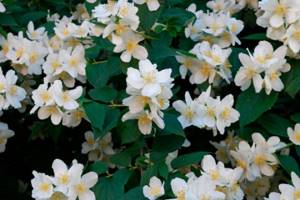
The southern European newcomer has taken its rightful place in gardens around the world. Selection of this variety of garden jasmine began in the 16th century.
A bush up to 3 m in height forms a lush crown - up to 2 m in diameter. Even young shoots are covered with exfoliating bark of a red-brown and yellowish hue.
The leaves are deep green, oblong and pointed. Their reverse side is pubescent with veins. Fragrant inflorescences, consisting of 3 - 5 simple creamy-white flowers, cover the bush for 3 - 4 weeks, starting from the 5th year of life.
Philadelphus coronarius (Latin version of the name) is one of the longest-living representatives in its family. According to the description and photo, the crowned mock orange in nature can reach an age of 80 years. Moreover, it blooms for at least 30 seasons.
Breeders have worked a lot on the oldest type of jasmine. Many varieties have been created that differ in flower structure and other characteristics. Among the most famous hybrids, gardeners note Innocence, Variegatus and Aureus.
Fluffy
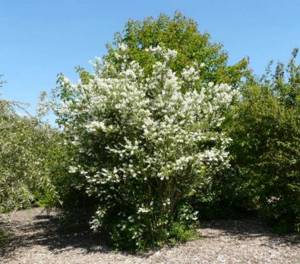
This type of garden jasmine got its name because of the airiness of the lower leaves. Layered brownish bark covers the shoots only from below. Lush cups of snow-white flowers, collected in inflorescences (7-10 pieces each), are almost odorless. The shrub blooms by mid-summer. This is one of the late-blooming mock oranges.
This type of mock orange became the basis for the creation by Russian breeders of many varieties: Ballet of Moths, Zoya Kosmodemyanskaya, Unusual Pearl, Academician Korolev.
And although hybrids were bred several decades ago, they are still popular among gardeners.
small-leaved

Not only small leaves of about 2 cm are a distinctive feature of garden jasmine. The photo of mock orange does not convey its main feature - its unique strawberry aroma. Gardeners often call this species Strawberry.
A small (1.5 m) bush has an equally compact crown. Simple flowers are arranged singly or in small inflorescences. The bush usually blooms actively. It is covered with a snow-white blanket so much that its erect shoots bend, forming a cascade.
Based on small-leaved jasmine, amazingly beautiful hybrids Snow Avalanche, Ermine Mantle and Avalange were created.
Hybrid
This category includes many interspecific combinations that were created by breeders around the world. Among the most popular varieties, gardeners note French hybrids bred by Lemoine and Russian hybrids by Academician Vekhov, many of which received their own names.
Flower of the hybrid mock orange shrub Minnesota Snowflake in the photo:

By crossing various natural species of mock orange, new varietal characteristics were obtained. The main achievements were the production of two-color varieties of garden jasmine, increasing the flowering period and frost resistance of the crop.
Odorless
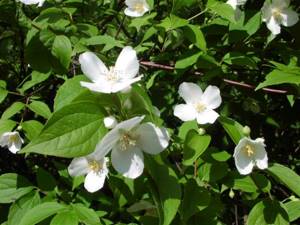
One of the tallest shrubs in the genus of garden jasmine. It reaches a height of 4 m, and its crown diameter is about 3 m. The plant is distinguished by long and lush flowering. But its main feature is the absence of aroma. Four- and five-petalled simple flowers are collected in brushes of up to 5 pieces. Their leaf blades are very long for mock oranges. On non-flowering shoots they can be up to 12 cm.
Lemoine

As a result of selection by the French originator Lemoine, the first hybrid with increased frost resistance and unique decorative qualities was developed. Currently, there are about 40 hybrid varieties of garden jasmine from the Lemoine workshop. Most of them are low-growing, reaching a height of no more than 1.5 m. At the same time, the crown of the bushes quickly grows to the same size.
The flowers of French mock orange hybrids are striking in their diversity. Among them there are terry varieties and two-color ones. Shrubs and foliage differ. Oval, ovate and pointed leaves can range from light green to soft golden color. The most popular varieties: Dame Blanche, Snow Avalanche, Avalanche Mont Blanc, Belle Etoile, Pyramidal.
Lemoine was the first breeder who managed to create mock orange with white and purple flowers. Natural specimens have only white or cream inflorescences.
Schrenk
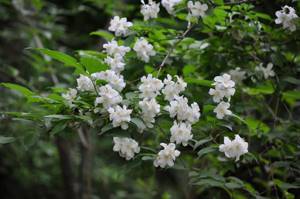
This tall mock orange received its name in honor of the famous Russian scientist and traveler Alexander von Schrenck. In nature, the shrub is found in the Far East and neighboring countries.
The shrub grows up to 3 m in height. The bark on its young shoots is brownish and covered with hairs. But from the second year of life it begins to crack and crumble. In this case, the color changes to grayish-brown.
The leaves of Schrenk's mock orange are ovate and slightly narrowed at the upper edge. Flowering shrub in early June in central Russia. Small (up to 4 cm) flowers with a delicate aroma are collected in clusters of 9 pieces.
History of selection
Crowned mock orange Schneesturm is a hybrid of a new generation of European selection. It belongs to the double varieties of garden jasmine, bred on the basis of the Virgin variety. The name of the plant is translated as “Snowfall” or “Blizzard” and gives an idea of the appearance of the bushes during the decorative period.
Chubushnik Shneeshturm belongs to the “snowy” European varieties of the Lemoine group. The plant has much in common with garden jasmines Snow Avalanche, Blizzard, Minnesota Snowflake and others.
The best varieties of mock orange
Among the many types and varieties of garden jasmine, you can choose a shrub for your garden that is ideal for its decorative qualities and growing conditions.
Fragrant varieties of mock orange
Most natural varieties of mock orange are fragrant. But breeders have enhanced this quality. If you need garden jasmine with a scent for your garden, then you should pay attention to the varieties Lemoine and Vekhova.
- Snow Avalanche is a miniature French hybrid (up to 1.2 m) that blooms from the end of June. Its tiny flowers emit a strong strawberry scent. The fragrance lasts about 2 weeks.
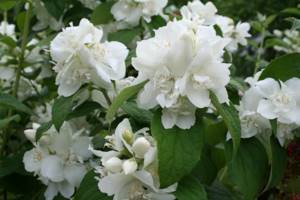
- Bouquet Blanc - called the White Bouquet. Terry inflorescences with a sweet aroma cover an almost two-meter bush for 3 weeks.
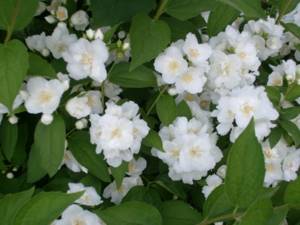
- Gletscher - blooms with double snow-white flowers for almost a month. Large inflorescences emit a scent similar to that of jasmine.
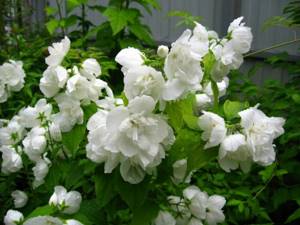
- Alabaster - combines double and single flowers during flowering. Their aroma is strong and pleasant.

- Airborne assault - surprises with drooping colors, similar to parachute domes in the sky. The aroma of this unique variety is strawberry, with a hint of exotic fruit.

- The miniature varieties of the Vekhov selection, Gnome and Dwarf, speak for themselves. From 50 to 80 cm in height, compact bushes emit a unique aroma when flowering.
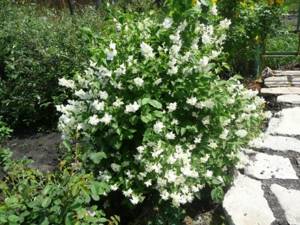
The most beautiful varieties of mock orange
It is difficult to argue about tastes, especially when it comes to such beautiful plants as mock oranges. Each hybrid is beautiful in its own way. Some are covered with double flowers, while others have an attractive petal shape or flower structure. And the height of splendor are varieties with two-tone colors. After all, absolutely all types of mock orange naturally bloom white or slightly creamy.
- Few people will be indifferent to the Salut variety. A shrub more than 2 m tall during flowering is strewn with inflorescences consisting of fairly large double flowers of a creamy-white color.

- The shoots of Komsomolets are slightly curved upward. Large (up to 4.5 cm) inflorescences cover the bush with a snow-white blanket. Flowers have an interesting structure. The lower petals are rounded and shorter than the upper ones. And the thin inner petals are enveloped by pale yellow stamens.

- Belle Etoile, or Beautiful Star, is a hybrid of the French Lemoine, which bears its name for good reason. The shrub has snow-white simple flowers with a purple center and yellow stamens. Flowering lasts about a month.
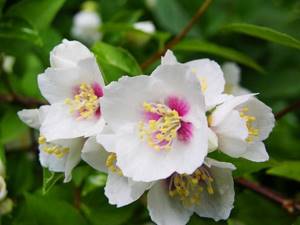
- Ballet of Moths is beautiful with its simple asymmetrical colors. During flowering, this lush, powerful shrub has almost no foliage visible.

- Bicolor - distinguished by large, about 5 cm, flowers. Its distinctive feature is the middle burgundy-pink color, against which the yellow delicate stamens stand out brightly.

- Schneeshturm is considered the furriest hybrid. Its flowers - very large and double - cover a three-meter bush for a month.

You can list the unusually beautiful varieties of mock orange for a long time, and every gardener will have his own favorite representative.
Frost-resistant varieties of mock orange
The shrub grows naturally in temperate climates. Most species easily tolerate winters with temperatures dropping to -20 °C. But for the cold climate of Russia, more frost-resistant varieties of jasmine are needed. It was precisely this quality that Academician N. Vekhov dealt with. He managed to breed hybrids that in open ground can tolerate frosts of -25 - 30 °C.
- Snow Avalanche - was created on the basis of another hybrid. Academician Vekhov improved the winter hardiness of the French garden jasmine variety Lavina.
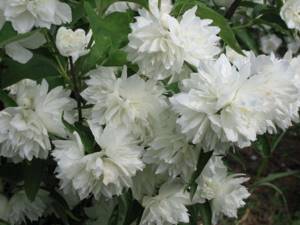
- Moonlight - tolerates frosts of -25 ° C quite easily. An amazing shrub with double greenish flowers.

- The flight of moths does not require shelter in frosts of about -30 °C. At lower temperatures, the tops of the shoots freeze.
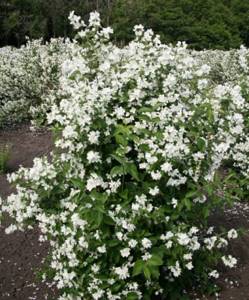
- Airborne landing - suitable for Siberia and central Russia.
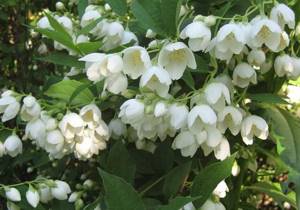
- The garden jasmine variety Zoya Kosmodemyanskaya with its large double flowers and unobtrusive aroma is suitable for Siberia and the Far East. In the northern regions, the crop grows well when covered for the winter.

Advice! Mock orange varieties, even with high resistance to frost, can freeze in particularly severe winters. To save the bush, it is enough to trim off the frozen shoots. The shrub quickly restores growth, and this has almost no effect on flowering.
Low-growing varieties of mock orange
In nature, mock orange is represented by species reaching 3 m in height. Thanks to scientists, varieties have appeared in our gardens that do not exceed a meter in height. Among them there are also very dwarf hybrids.
- Ermine mantle - 1 m;
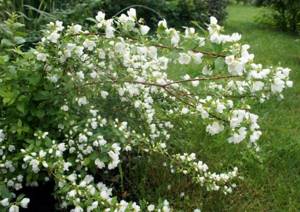
- Dame Blanche -1 m;
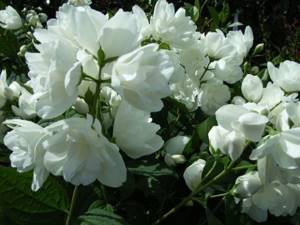
- Enchantment – 1 m;
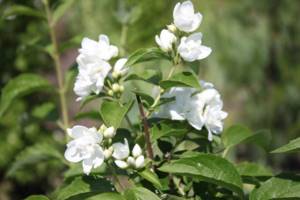
- Moonlight -70 cm;
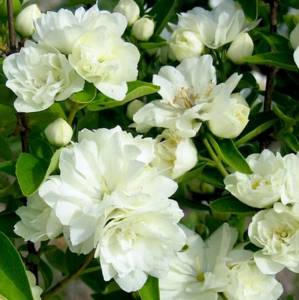
- Duplex – 60 cm;

- Gnome - 50 cm;
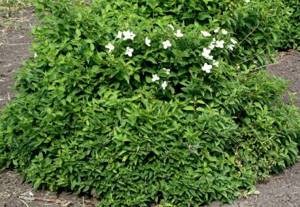
- Dwarf - 30 cm.
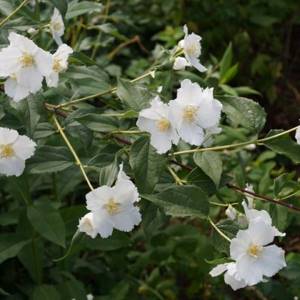
Interestingly, the crown diameter of these miniature garden jasmine bushes can be several times greater than their height.
Tall varieties of mock orange
In addition to the already mentioned Blizzard and Minnesota Snowflake, experts call the following varieties of garden jasmine, reaching 3 or more meters in height, tall:
- Pyramid;
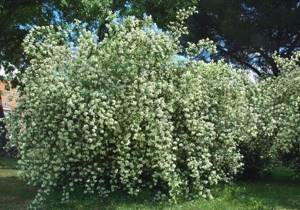
- Kazbek;

- Gordon's mock orange, which reaches 5 m in height.
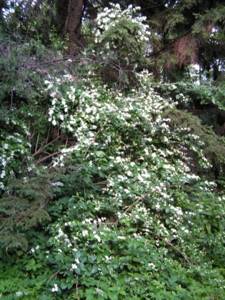
Tall shrubs are suitable for the back line of garden compositions.
How to choose the right variety of garden jasmine
It is difficult to decide on the choice of garden jasmine variety. Each of them is remarkable in some way. In order not to make a mistake, you should buy seedlings in specialized establishments. In the nursery you can learn about the types of mock orange with photos and descriptions. Important to note:
- The frost resistance of garden jasmine should correspond to the region of residence. In the warm southern climate, any variety will develop well. And in colder areas, species are needed that can withstand frosts of up to 25 - 30 °C.
- Before purchasing a false jasmine seedling, you need to decide on the planting location. If you are planning a hedge, then you should take a closer look at varieties no more than one and a half meters in height.
- Saplings with an open root system can be purchased for spring planting. In the fall, it is better to opt for seedlings in containers.
It is better for beginners to try their hand at low-growing varieties of mock orange. Unpretentious plants require less attention when growing.
Advantages and disadvantages of the variety
Chubushnik Shneeshturm looks very decorative in the garden and does not have strict requirements for cultivation. But besides the advantages, the variety has some disadvantages, and they also deserve attention.
| Pros: · beautiful white flowering; · pleasant aroma; · fast growth; · resistance to diseases and pests. | Minuses: · cannot be propagated by seeds; · reacts poorly to drought and excess moisture; · poorly suited for cultivation in the Urals and Siberia. |
The advantages of the Shneeshturm variety generally outweigh the disadvantages. But when growing garden jasmine, you will need to especially carefully monitor the condition of the soil.
